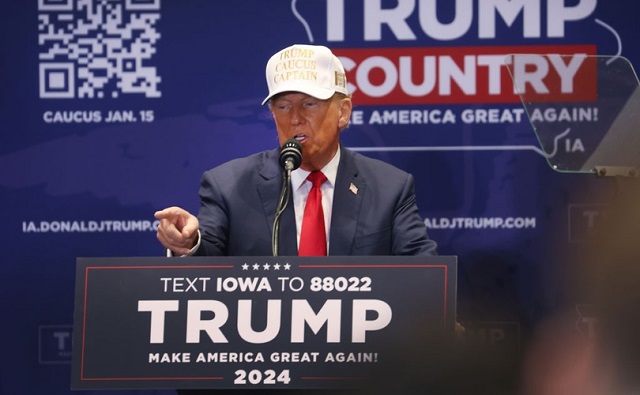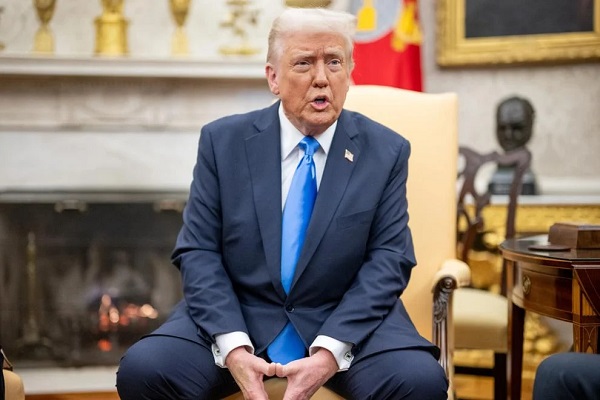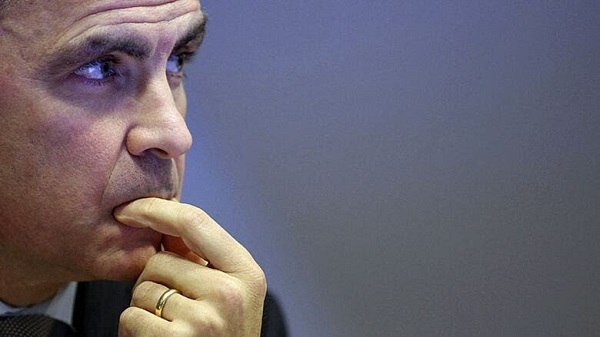By Ashley Sadler
The former president reportedly took home 51% of the vote. He has consistently held a commanding lead over his nearest competitors.
DES MOINES, Iowa — The Associated Press called the Iowa caucuses for former U.S. President Donald Trump on Monday night, with Trump scoring an unprecedented victory in the nation’s first nominating contest of the 2024 election cycle. The victory came after Republican voters in Iowa took to the ballots despite blizzard conditions as the fight for the White House begins to take shape.
The Associated Press called the election for Trump just 30 minutes after voting began. Early numbers showed Trump taking home more than 50% of the vote while Haley and DeSantis struggled for second place with roughly 20% of the vote each.
Later Monday night, Trump was the decisive victor with 51%. DeSantis was reported as having nabbed second place with just over 21% of the vote, edging out Haley who scored 19%.
Ramaswamy, in fourth, has officially dropped out of the race and announced his endorsement of Trump.
Responding to the news of his victory on Truth Social, Trump wrote, “THANK YOU IOWA, I LOVE YOU ALL!!!”
Reuters noted that the former president’s massive win in Iowa represents “an unprecedented margin for an Iowa Republican contest.” Prior to Monday night’s victory, the outlet noted, “The largest margin of victory for an Iowa Republican caucus had been 12.8 percentage points for Bob Dole in 1988.”
While Trump has been the far-and-away favorite of Republicans by polling data, it remains to be seen how good of a predictor the Iowa results will be given some unique conditions for the state this year.
Election watchers had predicted that the Iowa caucuses could suffer from low participation due to record-breaking winter weather that would likely keep many Iowans indoors and off icy roads.
Describing the brutal wintry conditions as “intimidating even for Iowa,” the Associated Press suggested that “[e]lderly Iowans, the backbone of the caucus,” had been “wondering how they will make it to their [voting] sites Monday.” The hazardous conditions have left “[p]olitical types … mentally downgrading their expected turnout and wondering who a smaller, harder-core electorate will favor.”
On Sunday, Trump joked to rally-goers that voting was so important that Republicans should head to their voting locations even if they had to risk death.
“If you want to save America from crooked Joe Biden, you must go caucus tomorrow,” Trump told the crowd. “You can’t sit home. If you’re sick as a dog, even if you vote and then pass away, it’s worth it.”
“You get up, you’re voting,” he said.
“You be safe and all, you’re going to be safe,” Trump told supporters. “Again, all indoors, it’s going to be all indoors. But you gotta get up, you gotta vote because it has nothing to do with anything but taking our nation back, and that’s the biggest thing there is.”
Trump’s big Monday night win comes as the Republican field has significantly winnowed, even ahead of Ramaswamy’s decision to step off the campaign trail. Facing an insurmountable lead by Trump, Haley and DeSantis have been left merely fighting for second place.
After a high-profile endorsement and cash influx from the Americans for Prosperity Action super PAC last month, Haley began to outpace DeSantis for the second-place slot behind Trump, who has consistently held a crushing double-digit lead over his nearest competitor. The latest polling data has appeared to line up with the Iowa results, showing Trump far ahead of Haley, followed by DeSantis in third place and entrepreneur Ramaswamy bringing up the rear.
The results come even as Trump has kept an uncharacteristically low profile in the lead-up to the primaries, contending with a barrage of legal challenges and even efforts to remove him from state primary ballots while nonetheless enjoying extremely high levels of support among the Republican base. DeSantis’ stagnant campaign has meanwhile proved a disappointment to supporters who rallied behind him after his strong conservative leadership during the COVID-19 pandemic and staunch advocacy for right-wing cultural issues.
While Trump appears an almost definite pick for the nomination, speculation has abounded concerning who he will choose as a running mate.
The former president’s recent comments lashing out at pro-MAGA Ramaswamy have dampened rumors he might choose the young firebrand for his second in command. Meanwhile, Haley’s gains in the polls had made her the subject of vice presidential rumors. Choosing Haley could signal that Trump is looking to move further to the center rather than the right as he aims to secure a second term in the White House, something pro-life Americans have already noticed as Trump has touted abortion exceptions and rejected a federal ban.
However, Haley has sought to distance herself from the speculation, and on Sunday Trump appeared to dismiss her, suggesting the 51-year-old wasn’t “tough enough” to handle the duties of the presidency, particularly dealing with dictators in nations like Russia and China.
Meanwhile, the Iowa caucuses are just the start of the Republican primaries. Voters in New Hampshire will have the next opportunity to choose who they would like to lead the party. The New Hampshire primary election will take place January 23.












